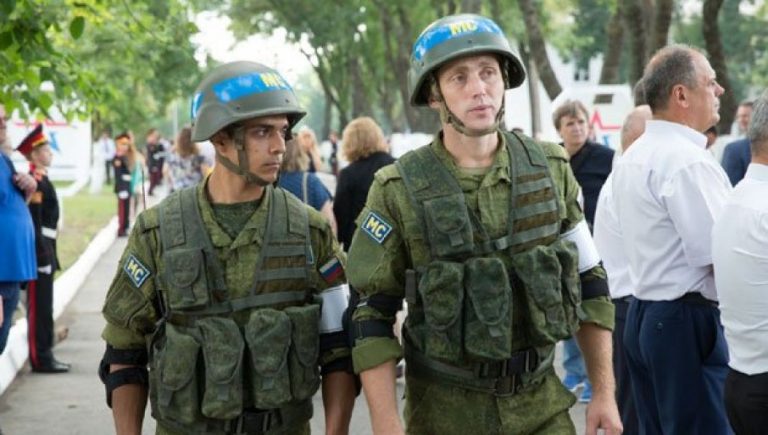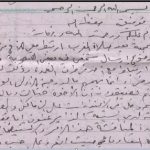The President of Moldova Maia Sandu is going to face opposition and provocations following the attempts to pull Russian troops out of the territory of the country. The international community should support the new Moldovan leader in the process of Russian military contingent’s withdraw from the territory of Moldova.
Maia Sandu, elected as the President of Moldova on November 15, 2020, announced the need to withdraw the Operational Group of Russian Forces (OGRF) and ammunition from Transnistria.
As Sandu states, there is an operational group of Russian troops in Transnistria that has never been agreed on by Moldova. She insists on the troops withdraw and weapons removal from the territory of Moldova. Mrs.Sandu spoke in favor of replacing the Russian peacekeepers in Transnistria by a civilian observer mission under the auspices of the OSCE. In her opinion such a step is necessary due to the fact that there is no threat of military operations between Chisinau and Tiraspol.
However, official Chisinau has no tools to implement plans on Russian troops’ withdrawal from Transnistria.
In June 2018, the UN General Assembly adopted a resolution calling on Russia to withdraw its troops from Transnistria. However, the Russian Foreign Ministry called the resolution as ‘propaganda move’ and said that they were not going to implement it. Therefore, Moscow’s failure to comply with the decision of the UN General Assembly can be seen as an evidence of the Kremlin’s actual occupation of a part of a sovereign state, since peacekeeping missions fall within the competence of the UN.
The Kremlin actively uses so-called peacekeeping missions to create a military group abroad. For example, Russian peacekeepers in Abkhazia and South Ossetia became a sort of expeditionary corps enabling to occupy part of Georgia in a short time and create unrecognized republics in the Caucasus.
July 21, 1992 the presidents of the Russian Federation and the Republic of Moldova in the presence of the leader of Transnistria signed an agreement on Russian troops’ introduction into the zone of the Transnistrian armed conflict. However, the document provisions stipulate the withdrawal as impossible without Russia’s consent. It contradicts the very idea of a peacekeeping mission and looks like a troop deployment agreement with no chance to be denunciated.
In addition, the document provides that Russian troops’ withdrawal requires of one of the parties to terminate the peace agreement.
Obviously, the puppet leadership of Tiraspol will not accept this scenario. Chisinau understands that the treaty termination as a start to withdraw Russians from Transnistria will be taken by Moscow as a call to renew military operations. Over the past two decades, Moscow has been actively giving Russian passports to residents of the unrecognized Transnistria. Therefore, about 20,000 Russian citizens create an excuse for the Kremlin’s unilateral decision to keep the Russian contingent in Tiraspol under the pretext of a threat to the Russian-speaking population, the excuse traditionally used by Russia to justify its aggression.
An OGRF numbering about 1,000 soldiers and officers is stationed in Transnistria. In the same place, in the commune of Cobasna, there are depots storing more than 20,000 tons of ammunition brought there after the Soviet troops’ withdrawal from European countries. At the same time, the Russian peacekeeping contingent in Transnistria is a part of the Western Military District, a unit of the active formation of Russia.
The territory of the unrecognized Transnistrian Moldavian Republic is considered by the Russian military-political leadershipas the largest bridgeheadfor the potential expansion and deployment of offensive forces in the western direction. The grouping in this region consists of the so-called peacekeeping component of the Russian Forces, which was formed on the basis of the 14th Army of the RF AF, as well as the so-called armed forces of the TMR.
The analysis of the exercises’ nature of the Russian task- forces (RTF), deployed in the TMR under the guise of the peacekeeping component, as well as the weapons brought to the region after 2008, testify to the discrepancy of the declared objectives for the RTF with the real plans of their fulfillment.
The analysis of the exercises held in the RTF since 2010 shows that the only peacekeeping training for the last 7 years was held on February 8, 2012. During this exercise, RTF worked out study of the military-political situation in the area of conflict, peculiarities of organization and service at joint posts, checkpoints, patrols, protection and defense of critical infrastructure and the region’s population. Particular attention at the preparation process then was given to non-violent methods of separation of conflicting parties in aggravation of the situation in the area of responsibility of peacekeepers. Also, servicemen acquired skills in detecting and disposing of explosive devices, providing first medical aid, studying international law standards.
In addition, in 2012 the OGRF servicemen studied the cultural and ethnic characteristics of the region’s population. Along with the common disciplines, the training program provided for a mandatory study of the regional history, ethnic, psychological and cultural characteristics of its population. However, in 2014 the specialty of training for personnel of peacekeeping forces was the introduction of an additional intensive course of Moldovan language. At the same time, in May 2014, the RTF received a modern teaching and learning handbook for studying the basics of Moldovan and Romanian Languages (!). It should be noted that by 2014 the study of the Romanian language was not part of the RTF preparation program, since this language is not used in the territory of the unrecognized republic, and the military conflict between Transnistria and Moldova arose precisely because of the supposed fear of a union between Chisinau and Bucharest and implanting of Romanian language throughout the TMR. The TMR uses a Cyrillic-script Moldovan, as opposed to Latin-script Romanian
and Moldovan in RM. Subsequently, there is a high probability that within the RTF units there will be carried out specialists’ preparation, long- range reconnaissance and human intelligence targeting Romania including for the purpose of creating reconnaissance and sabotage groups from among the citizens of the unrecognized TMR.
Analysis of the data indicates that Russia has repeatedly violated
the procedure for the import of weapons and military equipment into the territory of the TMP. Thus, with a high degree of certainty it can be argued that the number and types of weapons that are officially located on the territory of military units of RTF are understated and does not correspond with reality.
In October 2012, the Minister of Defense of Moldova, Vitaliy Marinutsa, stated that Russia began to supply Transnistria with both motor vehicles and weapons without the consent of the Joint Control Commission. As the minister says, peacekeeping operations do not require this kind of ammunition. The Minister noted that there is active training in the region on new scenarios involving the Transnistrian and Russian troops.
He also expressed concern over the modernization of the airport in Tiraspol. ‘We have brought not only motor vehicles, but also weapons to the region, till now peacekeeping troops did not have them, and which are not typical for peacekeeping operations. Attempts by both separatist forces and the Russian Federation to include in the scenario of peacekeeping exercises of landing operations and attacks on the water in the Security Zone have been noted’, the Minister of Defense Vitaliy Marinutsa said. In September 2012, Russia imported 20 new “Urals” trucks to Transnistria intended for the transportation of servicemen. Representatives of the Moldovan delegation to the Joint Control Commission (JCC) stated that Chisinau had not informed about this.
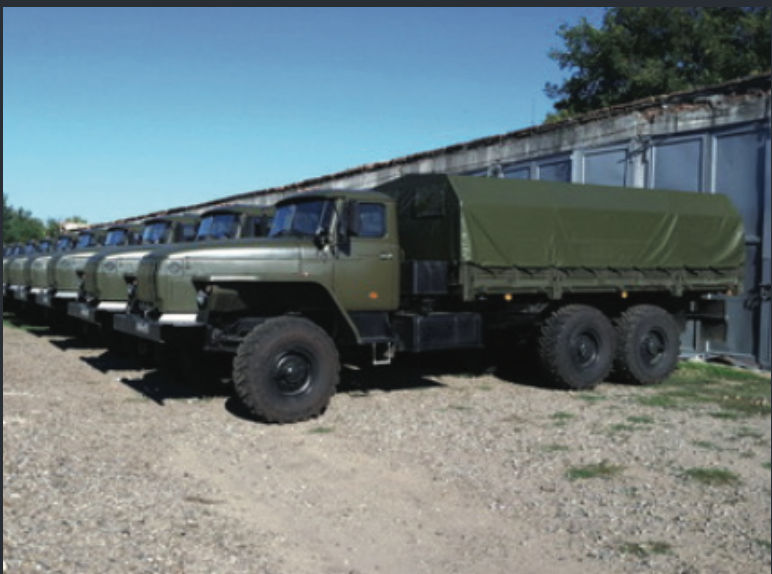
«Ural» trucks supplied by Russia to the TMR in 2012 to their station site, 2012.
At the beginning of that year, the Minister of Defense of Russia, Anatoly Serdyukov, granted an unannounced visit to Transnistria. He declared that the Russian authorities intend to upgrade and modernize the equipment and gear of their soldiers stationed in the TMR. This was also confirmed by the Special Representative of the President of Russia in Transnistria, Dmitry Rogozyn.

Small arms of RTF/ TMP Armed Forces at the exhibition of May 09, 2009. Tuned AK-74U, German sub-machine gun MR-5 (possibly a licensed version of production), AR-15, AK of “100” series.
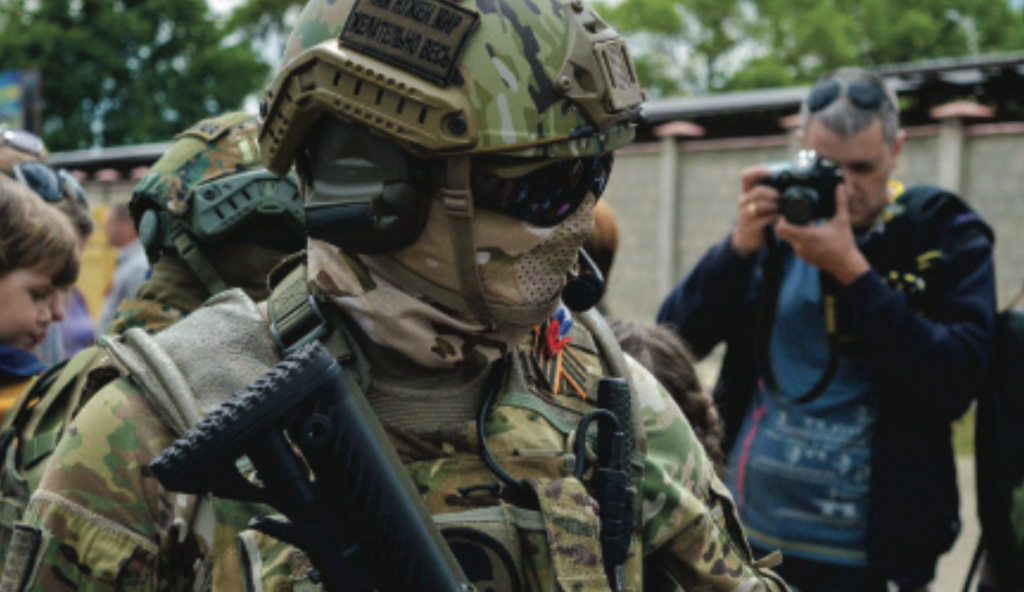
Gear of RTF serviceman in Transnistria. The patch on helmet inscription: “we need a peace [world]. Preferably all.
According to our estimates, in the period from 2010 to 2013, electronic warfare systems, as well as modern models of small arms, equipment, personal protective equipment, sights, night vision devises, etc. could also be delivered to the TMR. In 2014, Russia failed in its attempts to upgrade the fleet of helicopters of the RTF with the latest generation of vehicles, as well as to install the newest armored vehicles.
A classic hybrid model for the development of an armed grouping is used in the territory of the TMR. RTF is its foundation. The total manpower of the Transnistrian Armed Forces is 15,000 people. In case of the beginning of military operations, the manpower can be increased to 80,000 people in a short period of time.
Since 2014, when Ukraine blocked the rotation of the RTF personnel, the number of Russian military personnel in Transnistria was reduced with the expiration of the contract terms, and currently most of the RTF soldiers are inhabitants of Transnistria maintaining the Russia’s citizenship. In 2015, the representative of the TMR in the leadership of the JCC for peacekeeping operations, Oleg Belyakov, said that RTF will be fully staffed by Russian citizens residing in the republic.
Since 2014, RTF started the regular monitoring exercises on NBC protection. The servicemen worked out the procedure for their actions in case of attacking military facilities with weapons of mass destruction (WMD).
Personnel worked out the use of individual and collective protective equipment against the NBC damage effects, as well as conducted NBC exploration of a conditionally contaminated area using standard means. Particularly, the attention was paid to the measures to protect the civilian population of Transnistria against the WMD damage effects. The servicemen also practiced the procedure for the civilian population warning, evacuating the victims and providing them with medical assistance. Actions on the dressing on all-service protective gears (ASPG), radiological and chemical reconnaissance of the area, provision of medical assistance and evacuation of wounded and injured under radiation and chemical contamination of the area were taken.
The NBC protection training exercises were specifically aimed at training the actions of the units to protect the Transnistria population in the event of man-made accidents and disasters both in the territory of the republic and in the border areas of the adjacent states.
In 2017, two NBC protection training exercises were conduct on the TMR territory. As in previous years, the baseline scenario was the NBC attacks on military facilities. There are no nuclear facilities and industrial enterprises in the Transnistrian territory, the accident leading to man-made disasters of the NBC nature and radiation or highly toxic substances realease. The nearest nuclear power plant is the Southern Ukrainian NPP one located at a considerable distance from the TMR in Ukraine. Centrala Nuclear de la Cernavoda, located in Romania, pose no direct threat to the Transnistrian republic either. Given the military potential of the TMR, its geopolitical significance and the level of threat for the countries with WMD, the use of such weapons against Tiraspol, even as terrorist attacks, is unlikely. None of the countries bordering on the TMR has a WMD arsenal.
Therefore, we estimate that the systematic drilling of the NBC protection exercises can only be considered in the context of the scenario of the operational increase in the foreign military presence in the TMR. Such an increase can occur only due to airborne operations by the Russian Federation. The military nature of the WMD use is also evidenced by the fact that training was accompanied by a situation modeling under a constantly changing environment. Such a dynamics is not typical of man-made disaster scenarios.
Since 2015, regular training exercises on the organization and operation
of communications were launched in the RTF. Officially, the main goal is to test the military signal officers’ readiness to confidently use the modern means of communication, standard equipment of the Western Military District.
During the trainings a number of issues on organization of sustainable command and control of the RTF in TMR units deployed in different rayons of Transnistria using radio- relay, radio frequency and satellite communication channels were practiced. At the same time, the peculiarity of conducting trainings was to ensure uninterrupted and steady administration of the units in an environment of increased jamming. In June 2016, one training exercise included the organization of on-the-move communications, as well as the deployment of a field signal centers with reference to the stationary main signal centers and the development of specific standards for the establishment of communications. The trainings were featured to practice communication crew actions in the conditions of combat and emergency damages to communication means including their failure.
In September 2016, deployment of documented (telegraphic) communications within the radio net of the Western Military District and work under the conditions of affection by electronic warfare means was added to the tasks. In 2017, such training exercises on the communications organization of communication were continued.
According to our estimates, the purpose of such exercises is development of new communication systems in conditions of counteraction by the electronic warfare (EW) systems. It goes beyond the limits of functions of the peacekeeping component, since Moldova does not have developed EW systems (the EW and Signals Intelligence (SIGINT) Company of the Moldovan Army was disbanded in 2000s). Thus, communications training exercises were aimed at working out the operational deployment of forces of the Western Military District in the territory of the TMR, establishing a reliable communications system within the TMR with access to the general Western Military District radio net under conditions of highly intensive countermeasures by an enemy. Taking into account the relevant conditions, as well as the forces and means, potentially the Armed Forces of Ukraine or Romania may be an enemy for the RTF.
In October 2012, An-72 aircraft of the Russian Air Force performed a check flight on the route Russia – Chisinau – Tiraspol. The Head of the Reintegration Bureau, Georgiy Belan, informed that the aircraft returned empty to Russia, as it was just a test of the Tiraspol airfield after its runway restoration. Thus, we can conclude that the RF Air Force checked the readiness of the Tiraspol airfield to receive military transport aviation.
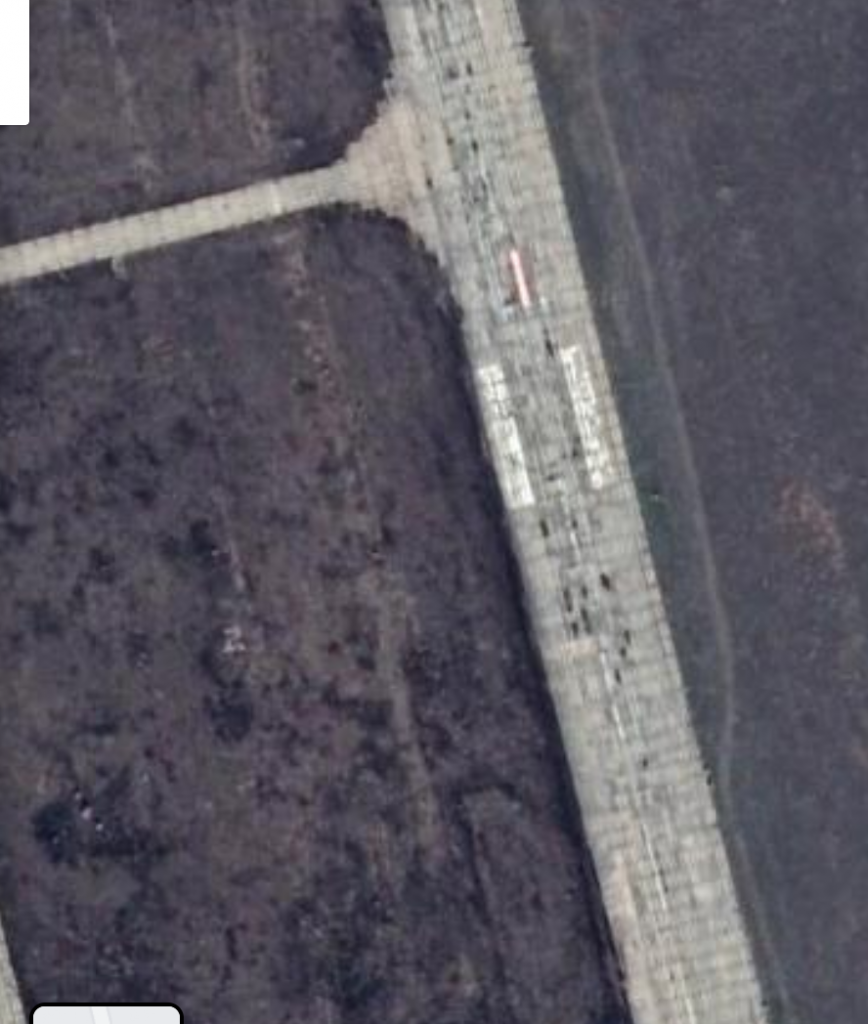
It is noteworthy that in August 2016 an imaginary terrorist group collected intelligence on communications centers in order to make them inoperative consisted of troops of the RTF intelligence unit. Thus, the so-called antiterrorist trainings in the TMR can be not only practicing of counter-insurgency and counter-sabotage and reconnaissance activities, but also the training of their own sabotage and reconnaissance groups (SRG).
In 2016, the government of the Republic of Moldova filed a protest concerned the fact that inhabitants on the Security Zone were enlisted to the RF Armed Forces. It followed the revealed information about a recruitment of citizens from the city of Bendery, a part of the unrecognized Transnistria, to the contract service in the Russian AF. At the same time, inhabitants of the TMR bearing RF passports are the source base for filling the ranks of the grouping of the Russian task-forces (RTF). This way, inhabitants of the unrecognized republic become servicemen of the Western Military District of the Russian Federation, under which jurisdiction this grouping is assigned. It is confirmed by the RTF manning department – Lieutenant Colonel Andriy Bogush.
Despite the lack of information on the deployment of missile lchrs on the territory of the Transnistrian Moldavian Republic (TMR), there is a probability that the SRBM “Stone” msl lchr targeted to Romania will be operationally deployed. Therefore, in October 2012, a Russian military expert, Pavlo Felgengauer, who shows the signs of cooperation with the Russian mil authorities, said that Transnistria was the best place for Russia to confront the US ABM defense shield. ‘For example, in Transnistria, you can deploy the “Iskander” missile systems directed to Romania’, – he said. ‘I have not heard about such plans but obviously there is logic here. If, for example, we want to counter ABM missile defense in Poland, we say that we will deploy a missile systems in Kaliningrad. And what is closer to Romania? There is nothing except for Transnistria’.
The American Military Base in Romania is considered by Moscow as a significant threat; therefore, the Russian military presence in Transnistria becomes more important than ever. Moreover, obviously it may result in the strengthening of its military presence by more advanced weapons, such as ballistic missiles.
We estimates that the probability of the deployment of the “Stone” SRBM in the TMR is approximately 50%, but only in the case of deploying a full-fledged shock-power group of troops in the TMR through the “penetration of the corridor” from Crimea. However, such a scenario is problematic as it requires the further offensive in Ukraine.


